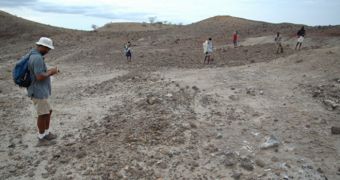New discoveries show that some of our earliest ancestors may have used tools. The data indicates that markings dating back more than 3.4 million years ago have been found on animal bones. The site is located within walking distance from the place where 'Lucy' was found.
This is the name experts gave to a hominin skeleton of the species Australopithecus afarensis, which they discovered in northeastern Ethiopia. The work was carried out as part of the Dikika Research Project, and the new data is quite stunning.
In essence, the discovery of these bone markings pushes back the established date of when our distant ancestors first began using stone tools by no less than 800,000 years. The conclusion was derived from studies conducted on four fossilized animal bone fragments that were found during the Project.
All of them were discovered very close to Lucy's location, by two investigators based at the Arizona State University. After zooarchaeological and archaeometric analyses of the fragments, the team reported that there is no way the markings on the bones are not caused by primitive stone tools.
The work lends additional credence to a theory the team published in the August 12 issue of the esteemed scientific journal Nature. That paper argued that A. afarensis was capable of using early stone tools to cut flesh of large carcasses. The work also suggested the hominins did so 3.4 million years ago.
The new data seems to agree. As a result, the use of stone tools, and the onset of carnivore among humans, is now pushed back by 800,000 years, from 2.6 to 3.4 million years ago. The work was conducted by ASU Institute of Human Origins paleoanthropologist Curtis Marean.
He is one of the world's foremost experts in bone studies, and his expertise proved invaluable for the new work. The scientist is also a professor in the ASU College of Liberal Arts and Sciences School of Human Evolution and Social Change.
The work is detailed in the Nature paper, which is called “Evidence for stone-tool-assisted consumption of animal tissues before 3.39 million years ago at Dikika, Ethiopia.” Experts in paleoanthropology, archeology, geology, paleontology and materials science also contributed to the investigation.
“To confirm that the cutmarks on the bones are ‘old’ and verify that they were induced by stone tools, I used the Environmental Cell Scanning Electron Microscope (E-SEM) and the attached Energy Dispersive X-ray Spectrometry (EDX) in ASU’s LeRoy Eyring Center for Solid State Science,” says Hamdallah Bearat.
The expert, who is based at the ASU School for Engineering of Matter, Transport and Energy, is a senior research scientist with degrees in chemistry, archaeometry, material science and engineering.
“This discovery dramatically shifts the known timeframe of a game-changing behavior for our ancestors,” concludes Zeresenay Alemseged, an anthropologist and the director of the Dikika project. He is also the director of anthropology at the California Academy of Sciences.

 14 DAY TRIAL //
14 DAY TRIAL //